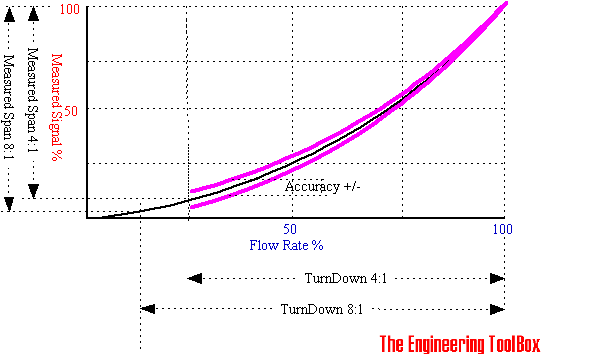Flowmeter - Accuracy
Introduction to accuracy in flow measurement devices.
Accuracy indicates how close a measured value is to the accepted or true value.
- "Accuracy is the degree of conformance of a measurement to standard or true value"

A measurement system consists normally of a primary element and a secondary element. Example - in a flow measurement system the orifice is the primary element and the pressure transmitter is the secondary element. Both the orifice and the pressure transmitter influence the flow measurement total accuracy.
The accuracy of flow meters can be stated as:
- percent of full span
- percent of rate
Accuracy as Percent of Full Span
Accuracy in percent of full span can be expressed as:
a% = a 100% / s (1)
where
a% = relative accuracy (%)
a = +/- absolute accuracy
s = full scale of the flow meter
Example - Accuracy of Flow Meter in Percent of Full Span
If the absolute accuracy is +/- 10 kg/h - the relative accuracy at full scale 1000 kg/h can be calculated as:
a% = (+/- 10 kg/h) 100% / (1000 kg/h)
= +/- 1%
The relative accuracy at full scale 100 kg/h can be calculated as:
a% = (+/- 10 kg/h) 100% / (100 kg/h)
= +/- 10%
Accuracy as percent of Rate
Accuracy in percent of rate can be expressed as:
a% = a 100% / q (2)
where
a% = relative accuracy (%)
a = +/- absolute accuracy
q = flow rate
Example - Accuracy of Flow Meter in Percent of Rate
If the relative accuracy is +/- 1% of rate - the absolute accuracy at rate 1000 kg/h can be calculated as:
a = (+/- 1%) (1000 kg/h)
= +/- 10 kg/h
The absolute accuracy at rate 100 kg/h can be calculated as:
a = (+/- 1%) (100 kg/h)
= +/- 1 kg/h
Hysteresis
Hysteresis is the maximum difference between measurement readings at the same mechanical set point when the point is set from a value above the set point and reset from a value below the set point. Hysteresis can increase over time as a result of wear and tear of the mechanical parts.
Standard Deviation Estimate
Standard Deviation Estimate is the measure of dispersion of a set of data in its distribution about the mean of the set and can be expressed as
S = (Σ(qa - qi)2 / (n - 1))1/2 (3)
where
S = standard deviation estimate
qa = mean value of measurements
qi = each individual measurement value from the set
n = number of values in the set of measurements
The mean value can be calculated as
qa = Σqi/ n (4)
Example - Estimated Standard Deviation
The flow through a flow meter is measured to 10 kg/h, 9 kg/h and 8.5 kg/h.
The mean flow can be calculated as
qa = ((10 kg/h) + (9 kg/h) + (8.5 kg/h)) / 3
= 9.2 kg/h
The standard deviation can be estimated as
S = ((((9.2 kg/h) - (10 kg/h))2 + ((9.2 kg/h) - (9 kg/h))2 + ((9.2 kg/h) - (8.5 kg/h))2) / (3 - 1))1/2
= 0.76 kg/h



